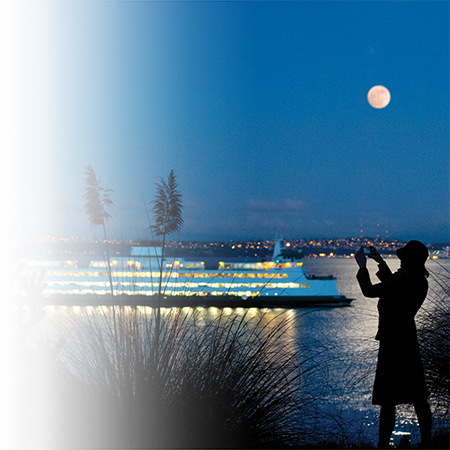Nighttime provides for a unique setting. But to take great pictures, you’ll need to make up for the lack of light. With a few techniques and the right equipment, you’ll be able to capture the magic of the night and take photos that are full of light and movement.

Essential night-time photography equipment
The secret to taking great night shots is to make sure your exposure time is fairly long (up to 30 seconds). A tripod is practically essential for taking night shots, too. If you don’t have one, find something stable to rest your camera on. Ideally you should use the shutter-release button to reduce the risk of blurred shots.

Choose the right settings
Before you do anything else, disable the automatic flash. It won’t be powerful enough to light your nighttime subjects.
Point-and-shoot cameras
Most of these cameras feature modes for night shooting ("Night Portrait" and "Night Landscape"), which offer greater sensitivity and longer exposure times.
- If it's an option on your camera, choose the "Aperture Priority" setting (abbreviated as "A" or "Av"). Set the exposure, white balance and exposure time manually, as you would with a Reflex camera.
- Otherwise, use the wide-angle lens (without zooming) to let in as much light as possible.
- If you have a point-and-shoot camera, don't increase the ISO beyond 800 or you'll end up with pixelated shots.

Reflex cameras
Reflex cameras, which offer a lot of settings when in manual mode (abbreviated as "M"), are perfect for taking night shots. Here are the recommended settings:
- White balance: Depending on how much light is available, carry out some tests to figure out the best setting. Most people opt for the "Tungsten" setting. Otherwise, take photos in RAW mode, so you can easily touch up colours and whites with your photo editing software.
- Aperture: Opt for a small aperture (f/8 to f/11).
- Sensitivity: Use a low ISO sensitivity (ISO 100 to 200). If you don’t have a tripod, bump up your ISO to reduce the risk of blurred shots.

Taking shots of the city at night
The advantage of a long exposure time is that it produces trails of light behind any moving vehicles you snap.
- Choose a shooting location that will allow you to capture trails of light in the streets.
- Stand on a corner: The cars’ headlights will produce beautiful, fluid and colourful curves.
- Near a river, lake, or fountain? Opt for a longer exposure (20 or 30 seconds) so you can capture the smooth and magical reflections on the water.
- If you’re surrounded by streetlights, use a lens hood to reduce flare.

Night portraits
If you want your subjects to stand out from the backdrop, without the latter looking too dark, select the “Night Portrait” or “Night Landscape” mode that you’ll find on most point-and-shoot cameras. The camera will then automatically revert to a slow shutter speed and adjust the flash accordingly. As a result, your subjects will stand out clearly and the backdrop will remain visible. To get the most out of this mode, make sure to:
- Use a tripod or something else to stabilize your camera so your photos don’t turn out blurry;
- Ask your subjects to stand still during exposure;
- Stand at least five metres away from your subjects.


